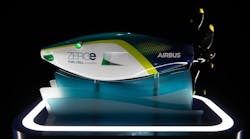THE MIL & AERO VIDEO BLOG, 4 June 2012. The U.S. Office of Naval Research (ONR) in Arlington, Va., is leading the charge to develop a new generation of large, long-endurance unmanned underwater vehicles (UUVs) for conducing intelligence, surveillance, and reconnaissance (ISR) missions of hostile coastlines and harbors, as John Keller reports this week in the Mil & Aero video blog.
Transcript of video
This is the Military & Aerospace Electronics Report. I'm John Keller.
There's suddenly a lot of exciting work going on in unmanned underwater vehicles, or UUVs for short. One of the most influential research organizations pushing UUV technology forward is the Office of Naval Research, or ONR, in Arlington, Va.
Just last month ONR scientists revealed an $18 million contract with Lynntech Inc. in College Station, Texas, to develop a prototype propulsion and power system for a future long-endurance UUV.
The U.S. Navy is keen on developing these kinds of long-endurance UUVs for covert reconnaissance of shipping activity in potentially hostile coastal waters and harbors. While today's UUV technology could conduct these kinds of secret undersea spy missions for a couple of days, the Navy is pushing industry to develop unmanned submersibles that could operate autonomously in enemy waters for weeks -- maybe even months.
Now to do that, there's no known battery technology that could power a long-endurance UUV reliably. So, it's up to scientists at Lynntech, and others like them, to come up with undersea power and propulsion technology that's stealthy, reliable, and works for a very long time.
One of the areas that Lynntech researchers are looking at is long-endurance hydride peroxide fuel cell UUV energy system, which is sort of like an alkaline fuel cell, and is fueled by sodium or potassium borohydride, with hydrogen peroxide.
The good news here is this a hydride peroxide fuel cell might operate longer and less expensively than traditional fuel cell technology. The bad news is this approach can produce hydrogen as a byproduct, and if you've seen those old newsreels of the Hindenburg Disaster, well, you know how dangerously explosive that can be.
This isn't the only long-endurance UUV power and propulsion technology that ONR is working on. One of the marquee unmanned submersible programs ONR has in the pipeline is the Large Displacement Unmanned Underwater Vehicle, or LDUUV program. Now this project aims to develop a large unmanned submarine that operate in the open ocean and in coastal waters and harbors on missions lasting more than 70 days.
A little more than a month ago, ONR awarded a $5.9 million, three-year research contract to Hydroid Inc. in Pocasset, Massachusetts, to develop an autonomy testing system for the LDUUV Innovative Naval Prototype Technology program to develop machine autonomy and long-endurance propulsion systems for future large UUVs.
So the technology necessary to build large, long-endurance UUVs isn't here yet, but ONR is setting the table for these new kinds of unmanned underwater systems we might see fielded perhaps before the end of this decade.
There's plenty going on in traditional UUV technology, too. In April the Navy and General Dynamics introduced a quarter-scale model of the Surface Mine Countermeasure Unmanned Undersea Vehicle named "Knifefish," at the Navy League show in Washington. The future Knifefish is to be a heavyweight minehunting UUV for the of the Littoral Combat Ship Mine Countermeasures Mission Package.
In February the Navy awarded a contract to the Lockheed Martin Maritime Systems & Sensors (MS2) segment in Syracuse, N.Y., and its partner Atlas Elektronik GmbH in Bremen, Germany, for the Shipboard Mine Neutralization System-Seafox (SMNS-SF), which uses sonar and video sensors to detect, locate, and destroy enemy sea mines.
And just last week, UUV maker Bluefin Robotics in Quincy, Massachusetts, got a contract from a pretty famous undersea survey company named Phoenix International Holdings Inc. in Largo, Md., for one of the company's Bluefin-21 deep-dive UAVs.
If you don't know Phoenix International by its name, you might know the company for one of its most notable feats. This is the company that found the black boxes of from Air France 447, the widebody passenger jet that crashed into the Atlantic Ocean three years ago, killing all 228 aboard. The black boxes were located about twelve thousand feet beneath the Atlantic.
With an endorsement like that, we can be sure that Bluefin Robotics is going places. We can say the same about UUV technology in general.
For the Military & Aerospace Electronics Report, I'm John Keller.



